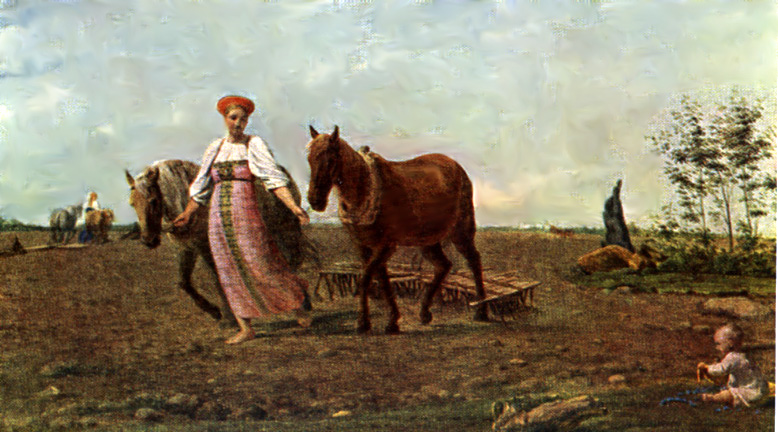| |
Though trained to become a land surveyor,
Alexei Gavrilovich Venetsianov, 1780-1847, was more interested in painting than
in anything else. He left his native Moscow and moved to St. Petersburg, where
he worked for a while as a post office clerk, but spent many hours in the
Hermitage copying the old masters. He studied for a while at the Academy, where
V.S. Borovikovski took him under his wing and even for a while took him into
this home. His name means Venetian and clearly shows that his ancestors were
Italians; nevertheless he was one of those un-Westernized Russians who, in the
beginning of the 19th century, became increasingly interested, and in some
cases even proud, of their adopted cultural heritage. They turned to the simple
people for their source, and Venetsianov was among the first to paint peasants
and the village life scenes. Sometimes even his style was reminiscent of the
loubok (the peasant woodcuts), particularly in his caricatures to which he
dedicated considerable attention. His entire work made Venetsianov father of
Russian genre painting.
Though he was appointed academician, Venetsianov was never satisfied with
imaginary landscapes or scenes from mythology, so dear to official academism.
For him the painter needed t get out of the studio and paint from nature,
exactly as his eyes saw it. When the Academy expelled a group of students,
Venetsianov, who opposed this drastic step, took the opportunity to return to
his estate at Safonkovo, located in the present Kalinin region. There he
founded his own school for a group of young painters, and offered a program
based on the principle that everything must be reproduced from nature as it is
and without imitating the style of any painter, no matter how famous he might
be. To put this into practice, he took his students outside of the studio and
they all painted portraits of the peasants, scenes from country life, flowers,
animals, everything that nature offered there. Among Venetsianov's most
interesting paintings are: "The Barn," which Nicholas I bought for
5,000.- Rubles, an enormous amount of money at that time, "The Threshing
Floor," "Sleeping Shepard," "On the Field," "The
Spring," "The Summer," "The Girl and the Calf,"
"Zakharka," "The Land Lady," "Fortune Telling"
and many others. Most of them reproduced with great accuracy the persons and
objects he painted; he did himself what he requested from his students. It is
true, though, that neither the teacher nor the students were able to completely
escape, some probably involuntarily, romantic approach and warm sentimental
feelings for the nature and the persons they painted. As the result of this,
the subjects came out embellished, confident and satisfied as the two peasant
girls look in the "Fortune Telling." Peace and permanence, maybe even
eternity, dominate on Venetsianov's canvases. The more the defenders of
Academism criticized Venetsianov; the more popular with the large mass of the
people his paintings became. They liked the calmness and idilic conditions that
they expressed; there was nothing in them that disturbed the eye or the
feelings. While the Academy refused his offer to return and teach, recognition
of his work came from the government and Nicholas I appointed Venetsianov a
court painter. But with the appointment came a change in his style, which
became more academic and tended towards sumptuousness. Here is a landscape
"Field in Spring". Please also see illustrations of
portraits.
|
|
